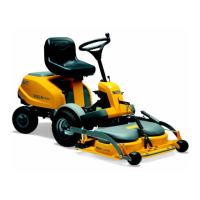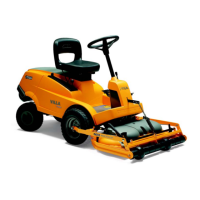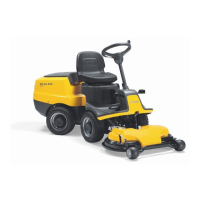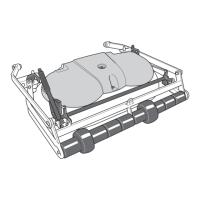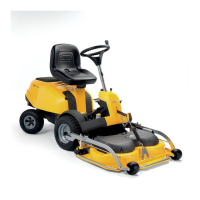49
ENGLISH
EN
5.2 Preparation
All service and all maintenance must be carried out
on a stationary machine with the engine switched
off.
Prevent the machine from rolling by al-
ways applying the parking brake.
Prevent unintentional starting of the
engine by disconnecting the spark plug
cable(s) from the spark plug(s) and re-
moving the ignition key.
5.3 Tyre pressure
Adjust the air pressure in the tyres as follows:
Front: 0.4 bar (6 psi).
Rear: 1.2 bar (17 psi).
5.4 Changing engine oil
Change engine oil for the first time after 5 hours of
operation, and subsequently after every 50 hours
of operation or once a season.
Change the oil more often (after 25 hours of oper-
ation or at least once a season) if the engine has to
operate under demanding conditions or if the am-
bient temperature is high.
Use synthetic oil of service grade SF or higher in
accordance with the table below.
Use oil without any additives.
Do not fill with too much oil. This can cause the
engine to overheat.
Change oil when the engine is warm.
The engine oil may be very hot if it is
drained off directly after the engine is
shut off. Therefore allow the engine to
cool a few minutes before draining the
oil.
1. Unscrew the oil drain plug (fig. 11).
2. Collect the oil in a collection vessel. Then take
the oil to a recycling station. Do not spill any oil
on the drive belts.
3. Screw in the oil drain plug.
4. Remove the dipstick and fill up with new oil.
Oil quantity: 1.4 l
5. After filling up the oil, start the engine and idle
for 30 seconds.
6. Check to see if there is any oil leakage.
7. Stop the engine. Wait for 30 seconds and then
check the oil level in accordance with 4.2.
5.5 Fuel filter (9:Q)
Replace the fuel filter every season. Check for fuel
leaks once the new filter has been installed.
5.6 Belt transmissions
After 5 hours of operation, check that all the belts
are intact and undamaged.
5.7 Steering
The steering must be checked/adjusted after 5
hours of operation and thereafter every 25 hours of
operation.
5.7.1 Checks
Briefly turn the steering wheel back and forth.
There must be no mechanical clearance in the
steering.
5.7.2 Adjustment (18:T)
Tension the steering cables by tightening up the
nut (fig. 16). Important! The screws in the ends of
the cable should be held firmly during adjustment
so that the cable is not twisted. Using an adjustable
wrench or similar, grasp the key handle on the
screws in the ends of the cable.
Adjust the steering cables until all play is removed.
Do not tension the steering cables too hard. Other-
wise the steering will be heavy and wear and tear
on the cables will increase.
5.8 Battery
Never overcharge the battery. Over-
charging can damage the battery.
Do not short-circuit the battery’s termi-
nals. Sparks occur which can result in
fire. Do not wear metal jewellery which
can come into contact with the battery
terminals.
In the event of damage to the battery
casing, cover, terminals or interference
to the strip covering the valves, the bat-
tery should be replaced.
The battery is a valve-regulated battery with 12 V
nominal voltage. The battery fluid does not need to
and cannot be checked or topped up. The only
maintenance that is required is charging, for exam-
ple after extended storage.
The battery must be fully charged be-
fore being used for the first time. The
battery must always be stored fully
charged. If the battery is stored while
discharged, serious damage will occur.
5.8.1 Charging with the engine
The battery can be charged using the engine’s gen-
erator as follows:
Use Oil
All temperatures SAE 10W-40
Below -18°C SAE 5W-30
Above 0°C SAE 30
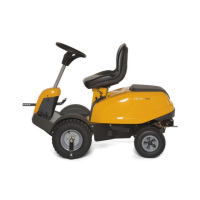
